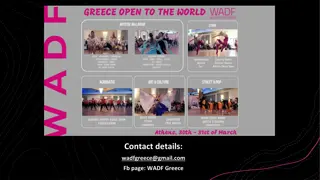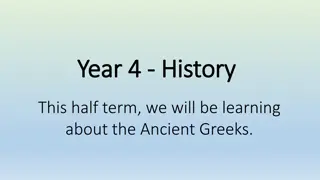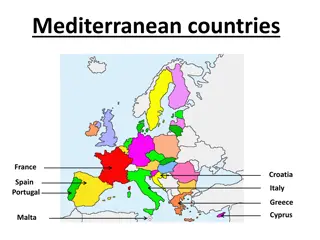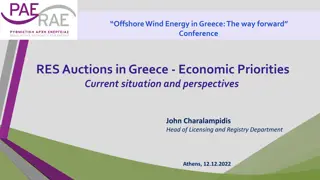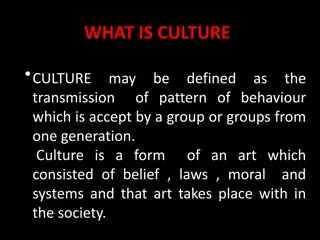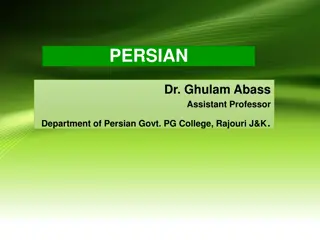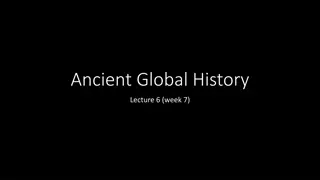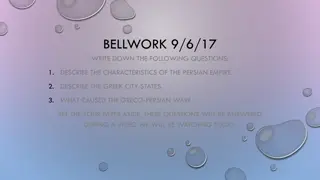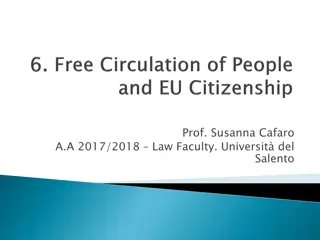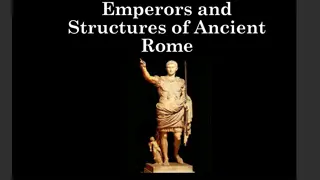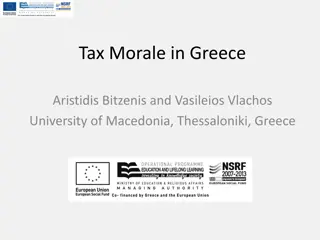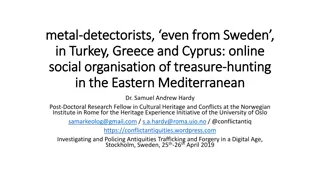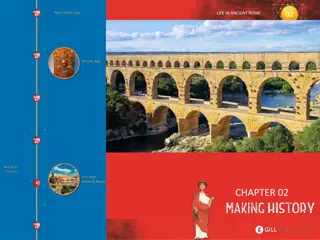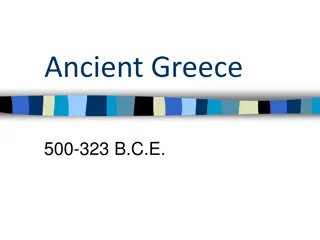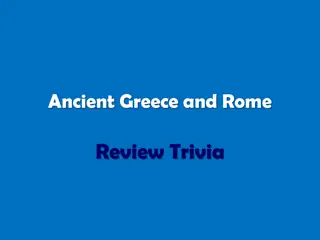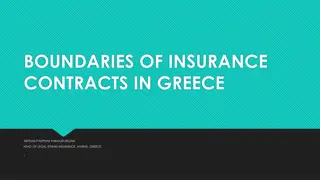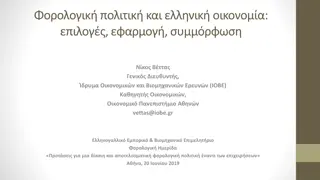Evolution of European Literature: Greece, Rome, and Beyond
European literature traces its origins to the ancient works of Greece and Rome, with masterpieces like The Iliad, The Odyssey, and the Old Testament shaping its early development. The Classical Period saw a flourishing of drama, poetry, and philosophy in both Greek and Roman civilizations. This rich literary tradition continues to influence and inspire writers worldwide.
Download Presentation

Please find below an Image/Link to download the presentation.
The content on the website is provided AS IS for your information and personal use only. It may not be sold, licensed, or shared on other websites without obtaining consent from the author. Download presentation by click this link. If you encounter any issues during the download, it is possible that the publisher has removed the file from their server.
E N D
Presentation Transcript
W: EUROPEAN LITERATURE Mr. Roman Magdua Jr.
EUROPEAN LITERATURE Greece and Rome are considered the birth place of European Literature. Literary pieces were conserved, remolded, and spread through Christianity and thus communicated to the diverse vernacular languages of the European Continent, both in the Western Hemisphere, and other regions the Europeans settled in. Today, this body of writing displays a unity in its main features making it different from the literatures of the rest of the world.
Ancient Period (750 BC 450 BC) The birth of the European literature can be traced back to circa 750 BC. It was the time when two significant literary works were developed. The first was the Old Testaments of the Bible which was composed of 39 books in Hebrew language. It is made of various genres which include lyric poem, tales, and histories. On the other hand was the realization of the timeless epics: The Iliad and the Odyssey which were associated with Homer.
Ancient Period (750 BC 450 BC) The Greek literary masterpieces were conceived by scholars to have been collected across years by poets using the oral tradition. Evidently, the Old Testament was highly religious and moralistic while the Iliad and Odyssey narrated the heroic deeds of Greek characters like Achilles and Odysseus who reflected the culture of warfare.
Classical Period (450 BC 1066 CE) As the beginning of the Current Era (CE) comes, Greece endured its reputation to be a cultural overpowering force. The Greek drama flourished during the 5th and 4th centuries BCE. The playwright of comedy (like Aristophanes) and tragedy (namely: Aeschylus, Sophocles, and Euripedes) became popular in this time. Notable lyrical poets like Pindar and Sappho were also famous. The varied works of the great philosophers: Plato and Aristotle were also eminent.
Classical Period (450 BC 1066 CE) The Greek tradition was later endured by the Romans, who resembled their civilization after Greeks. When Romans gained their imperial authority in 27 BC, the emperor Augustus Caesar urged to have a literary identity that would reflect Rome s potency.
Classical Period (450 BC 1066 CE) Approximately a decade after, the poet Virgil became renowned because of his Aeneid, an epic modeled on Iliad and Odyssey. Rome continued to produce literary giants in drama (Seneca, Terence, and Plaurus), poetry (Horace), and prose (Cicero and Apuleius).
Medieval Period (1066 1500) Medieval, belonging to the Middle Ages, denotes the literature of both Europe and the Eastern Mediterranean from the founding of the Eastern Roman/Byzantine, Empire about 300 AD for medieval Greek, to the period following the fall of Rome in 476 for medieval Latin, and from about the time of Charlemagne and the Carolingian Renaissance he fostered in France (c. 800) to the end of the 15th century for most written vernacular literatures.
Medieval Period (1066 1500) The central literary ideals of the period are found in works created from the dialect. The pre- Christian literature of Europe belonged to an oral tradition that was mirrored in the Poetic Edda and the sagas , or heroic epics, of Iceland, the Anglo- Saxon Beowulf , and the German Song of Hildebrand .
Medieval Period (1066 1500) Heroic deeds and dignified actuations were underscored in the epics like Beowulf (Anglo- Saxon), The Song of Roland (French), The Song of Nibelungs (German), and El Cid (Spanish). The culture of chivalric adventure was evident in the works associated to King Arthur, including Sir Thomas Malory s Le Morte d Arthur. Moreover, Geoffrey Chaucer gained his title as The Father of English Literature with his paramount literary work, The Canterbury Tales.
Renaissance Period (1485 1680) Renaissance( Rebirth ) refers to the historical period in Europe that occurred after the Middle Ages. This left behind the medieval ways of the past and launched a society towards a modern world.
Renaissance Period (1485 1680) The age was marked by three major characteristics namely: (1) the new interest in education, emulated by the classical scholars known as humanists and instrumental in providing appropriate classical models for the new writers;
Renaissance Period (1485 1680) The age was marked by three major characteristics namely: (2) the new form of Christianity, introduced by the Protestant Reformation headed by Martin Luther, which drew men s interest to the individual and his inner experiences and encouraged a response in Catholic countries summarized by the term Counter-Reformation
Renaissance Period (1485 1680) The age was marked by three major characteristics namely: (3) the journeys of the great explorers that culminated in Christopher Columbus discovery of America in 1492 and that had extensive consequences on the countries that developed overseas empires, as well as on the minds and consciences of the most exceptional writers of the era.
Renaissance Period (1485 1680) During this period, people were concerned with individualism, as well as self and societal improvement. The emergence of a fresh essence of intellectual and artistic inquiry, which was the leading feature of this political, religious, and philosophical phenomenon, was basically a resurgence of the spirit of ancient Greece and Rome. In literature, this intended a new attention and investigation given to the works of the great classical writers.
Renaissance Period (1485 1680) Scholars examined and translated lost ancient texts, whose distribution was much helped by developments in printing in Europe from about 1450. Art and literature in the Renaissance reached a height unattained in any previous period.
Renaissance Period (1485 1680) On the other hand, many writers produced literary pieces that catered to wealthy patrons who commissioned their work. In 1440, Johannes Gutenberg created the printing press, which allowed for mass production of pamphlets and novels. This event gave people more opportunities to read publication of authors like Petrarch and Boccaccio.
Renaissance Period (1485 1680) Following are notable literary works written during the Renaissance: Christopher Marlowe: Doctor Faustus Dante Alighieri: Divina Commedia Giovanni Boccaccio: The Decameron John Milton: Paradise Lost Miguel de Cervantes: Don Quixote
Renaissance Period (1485 1680) Following are notable literary works written during the Renaissance: Niccolo Machiavelli: The Prince Petrarch: Canzoniere, Trionfi Sir Thomas More: Utopia William Shakespeare: King Lear, Hamlet, Macbeth, Romeo and Juliet
Age of Reason (1650 1800) Also known as the Age of Enlightenment, the Age of Reason aims not to grab a hold on a useful half-truth but to cause misperception in the over-all picture, because the predominance of reason had also been a mark of certain periods of the previous era.
Age of Reason (1650 1800) In literature, the rational desire nurtured satire, argument, wit, plain prose; the other stimulated the psychological novel and the poetry of the magnificent. Since the print culture emerged from the previous period, the volume of printed reading materials increased.
Age of Reason (1650 1800) Literary works during this period centered on human nature, people-government relationship, property, natural laws and rights, and organized religion. Thus, this period caused a dramatic change in the political, economical, and social policies and beliefs of people.
Age of Reason (1650 1800) It is more precise to say that the 18th century was marked by two key impulses: reason and passion. The respect given to reason was displayed in search of order, regularity, propriety, and scientific knowledge; the refinement of the feelings roused compassion, exaltation of personal relationships, religious fervor, and sensibility. This period contributed to the betterment of humankind.
Age of Reason (1650 1800) Famous authors and their literary works during this period are: Adam Smith: The Wealth of Nations Daniel Defoe: Robinson Crusoe Denis Diderot: Encyclopedie Jean-Jacques Rousseau: The Social Contract, Emile, and Confessions. John Locke: An Essay Concerning Human Understanding
Age of Reason (1650 1800) Famous authors and their literary works during this period are: Jonathan Swift: Gulliver s Travels Mary Wollstonecraft: A Vindication of the Rights of Women Montesquieu: Spirit of the Laws Thomas Hobbes: Leviathan Voltaire: Candide
Romantic Period (1798 1870) Romanticism was the principal literary movement of the initial part of the 19th century, in which literature had its origins in the Sturm und Drang period in Germany. A consciousness of this first phase of Romanticism is an important modification to the usual impression of Romantic literature as something that began in English poetry with William Wordsworth and Samuel Taylor Coleridge and the publication of Lyrical Ballads in 1798.
Romantic Period (1798 1870) Here are the famous writers of Romantic period and their literary works: Fredrick Schlegel: Lucinde Georg Wilhelm Friedrich Hegel: Phenomenology of Mind Horace Walpole: The Castle of Otranto Johann Wolfgang von Goethe: The Sorrows of Young Werther, Faust
Romantic Period (1798 1870) Here are the famous writers of Romantic period and their literary works: Lord Byron: Don Juan, Childe Harold s Pilgrimage Mary Shelley: Frankenstein Samuel Taylor Coleridge: The Rime of the Ancient Mariner, Lyrical Ballads Victor Hugo: Les Miserables William Wordsworth: The Prelude
Modernism (1870 1965) Modernism, like realism, provided critique of morality of the people belonging to the middle- class society. Writers during this period explored new forms and styles of writing, which paved way to a technique called stream of consciousness. Developed by Marcel Proust, stream of consciousness is a style that allowed the author to explore all of the facets of their thought processes in the absence of any suggested formatting rules.
Post-Modernism Period (1965 present) Characterized by an unusual mix of high and low culture, this period served as the literary and societal response to the horrifying events of World War II and elitism of high modernism. Fragmentation, paradox, and narrators that are difficult to define are common. The style of writing evokes the absence of tradition in a modern consumer-driven, technologically based society.
Post-Modernism Period (1965 present) Authors began to use a jumble of various ingredients, known as pastiche, that had not been seen as appropriate for literature before, in order to create a more complex story, filled with allusions to events and style of other literary works that took a certain level of education to recognize or even begin to appreciate.
Post-Modernism Period (1965 present) Here are the post-modernist famous authors and their literary works: Alan Moore: Watchmen Alasdair Gray Lanark: A Life in Four Books Dmitry Galkovsky: The Infinite Deadlock George Perec: Life: A User s Manual Gertrude Stein: The Autobiography of Alice B. Toklas
Post-Modernism Period (1965 present) Here are the post-modernist famous authors and their literary works: Italo Calvino: If on a winter s night a traveler John Fowles: The French Lieutenant s Woman Umberto Eco: Foucault s Pendulum Venedikt Erofeev: Moscow-Petushki Vladimir Nabokov: Mother Night Walter Abish: How German Is It
W: PERFORMANCE TASK
PERFORMANCE TASK: Literature Presentation You will be divided into small groups. Choose a literary piece (novel or short story) from the region you are assigned with and make a presentation out of it. Author s Background Elements of the Story (Characters, Plot, & Theme) Personal lesson/s learned from reading the story.
PERFORMANCE TASK: Literature Presentation Record your presentation in google meet or zoom. You may open your cameras in the presentation. Be guided by the rubric. The output submission would be on the 2nd week of January*
PERFORMANCE TASK: Literature Presentation PRESENTATION (30 pts) (25 pts) (20 pts) CONTENT CREATIVITY ORGANIZATON (15 pts) LENGTH OF PRESENTATION (10 pts) The speakers deliver the message in a confident, poised, enthusiastic fashion. The volume and rate varies to add emphasis and interest. Pronunciation and enunciation are very clear. The speakers exhibit very few disfluencies, such as "ahs," "uhms," or "you knows." The speakers provide a variety of types of content appropriate for the task, such as generalizations, details, examples and various forms of evidence. The speakers adapt the content in a specific way to the listener and situation. Very original presentation of material; captures the audience s attention. The message is overtly organized. The speakers help the listener understand the sequence and relationships of ideas by using organizational aids such as announcing the topic, previewing the organization, using transitions, and summarizing. The presentation is performed within the allotted time limit.


